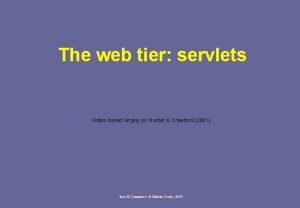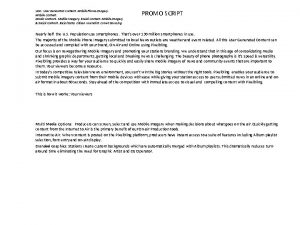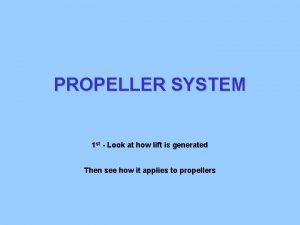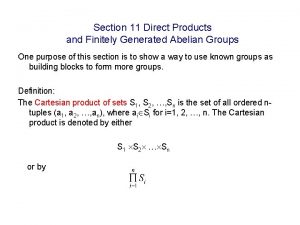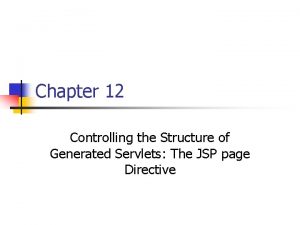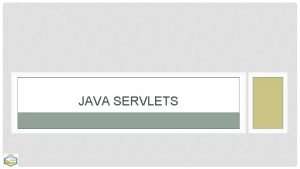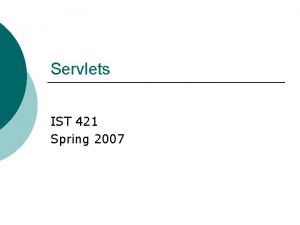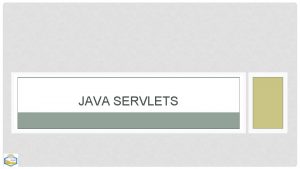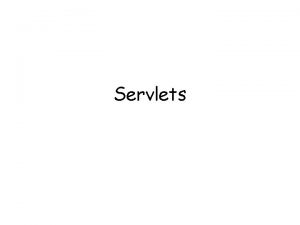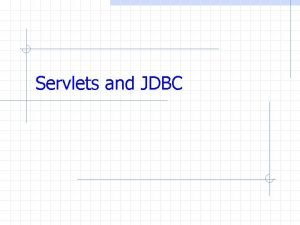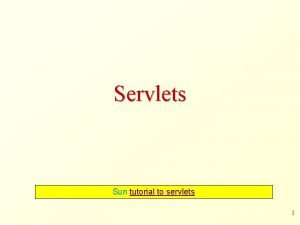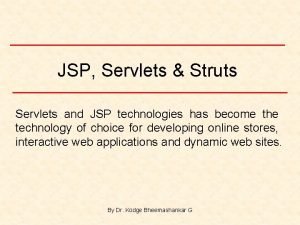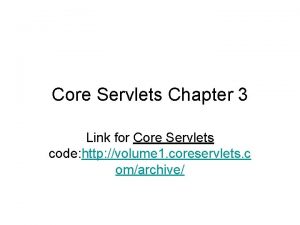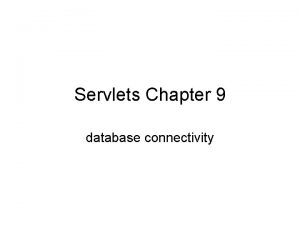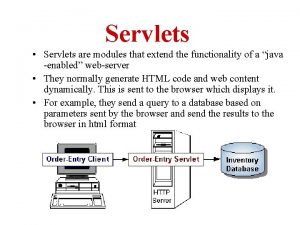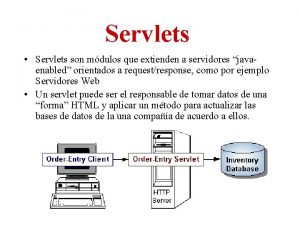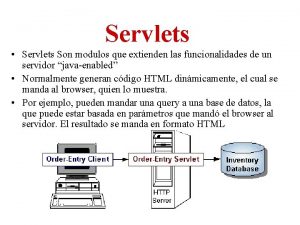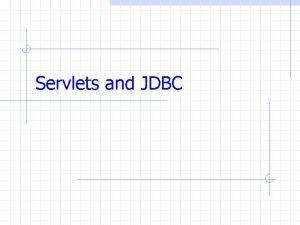CONTROLLING THE STRUCTURE OF GENERATED SERVLETS Unit 3


























- Slides: 26

CONTROLLING THE STRUCTURE OF GENERATED SERVLETS Unit – 3 K. Phani Sirisha

• In JSP, there are three main types of directives: Ø Ø Ø page directive include directive taglib directive • The page directive control the structure of the servlet by importing classes, customizing the servlet superclass, setting the content type, and the like. • The include directive insert a file into the JSP page at the time the JSP file is translated into a servlet. • An include directive should be placed in the document at the point at which you want the file to be inserted • The taglib directive defines custom markup tags

The JSP Page Directives: • A JSP directive affects the overall structure of the servlet that results from the JSP page. • The following templates show the two possible forms for directives. <%@ directive attribute="value" %> <%@ directive attribute 1="value 1" attribute 2="value 2". . . attribute. N="value. N" %> • Single quotes can be substituted for the double quotes around the attribute values, but the quotation marks cannot be omitted altogether. • To obtain quotation marks within an attribute value, precede them with a backslash, using ’ for ’ and " for ".

• A page directive can be placed anywhere within the document • The page directive define or more of the following case-sensitive attributes : import, content. Type, page. Encoding, session, is. ELIgnored (JSP 2. 0 only), buffer, auto. Flush, info, error. Page, is. Error. Page, is. Thread. Safe, language, and extends • Purpose of the page Directive: Can control – Which classes are imported – What class the servlet extends – What MIME type is generated – How multithreading is handled – If the servlet participates in sessions – The size and behavior of the output buffer – What page handles unexpected errors

The import Attribute • The import attribute of the page directive specify the packages that should be imported by the servlet into which the JSP page gets translated. • Using separate utility (helper) classes makes your dynamic code easier to write, maintain, debug, test, and reuse. • These utilities must use packages, and the JSP page should use the import attribute to utilize these classes • packages are a good strategy and packages are absolutely required in JSP because they help protect against name conflicts. • The reason is that, in the absence of packages, classes you reference are assumed to be in the same package as the current class. • Use of the import attribute takes one of the following two forms. <%@ page import="package. class" %> <%@ page import="package. class 1, ……. , package. class. N" %>

• By default, the servlet imports java. lang. *, javax. servlet. *, javax. servlet. jsp. *, javax. servlet. http. *, and possibly some number of server-specific entries • For example, the following directive signifies that all classes in the java. util package should be available to use without explicit package identifiers. <%@ page import="java. util. *" %> • The import attribute is the only page attribute that is allowed to appear multiple times within the same document. • The classes you write that are used by JSP pages must be placed in the special Java-code directories (e. g. , . . . /WEBINF/classes/directory. Matching. Package. Name) • The following JSP example page uses three classes which are not in the standard JSP import list: i. e java. util. Date, coreservlets. Cookie. Utilities and coreservlets. Long. Lived. Cookie • So, to refere these classes, the JSP page uses <%@ page import="java. util. *, coreservlets. *" %>

…<H 2>The import Attribute</H 2> <%@ page import = "java. util. *, coreservlets. *" %> <%! private String random. ID() { int num = (int)(Math. random()*10000000. 0); return("id" + num); } private final String NO_VALUE = “No Value"; %> <% String old. ID = Cookie. Utilities. get. Cookie. Value(request, "user. ID“, NO_VALUE); if (old. ID. equals(NO_VALUE)) { String new. ID = random. ID(); Cookie cookie = new Long. Lived. Cookie("user. ID", new. ID); response. add. Cookie(cookie); } %> This page was accessed on <%= new Date() %> with a user. ID cookie of <%= old. ID %>. </BODY></HTML>


The session Attribute • The session attribute controls whether the page participates in HTTP sessions. • Use of this attribute takes one of the following two forms. <%@ page session="true" %> <%-- Default --%> <%@ page session="false" %> • A value of true (the default) signifies that the predefined variable session (of type Http. Session) should be bound to the existing session if one exists; otherwise, a new session should be created and bound to session. • A value of false means that no sessions will be automatically created and that attempts to access the variable session will result in errors at the time the JSP page is translated into a servlet. • Using session="false" may save significant amounts of server memory on hightraffic sites. • However, note that using session="false" does not disable session tracking—it merely prevents the JSP page from creating new sessions for users who don’t have them already. • So, since sessions are user specific, not page specific, it doesn’t do any good to turn off session tracking for one page unless you also turn it off for related pages that are likely to be visited in the same client session.

The is. ELIgnored Attribute • The is. ELIgnored attribute controls whether the JSP 2. 0 Expression Language (EL) is ignored (true) or evaluated normally (false). • The is. ELIgnored option gives you the ability to disable the evaluation of Expression Language (EL) expressions which has been introduced in JSP 2. 0 • The value of the attribute is false, meaning that expressions, ${expression}, are evaluated as dictated by the JSP specification. If the attribute is set to true, then expressions are not evaluated but rather treated as static text. • This attribute is new in JSP 2. 0; it is illegal to use it in a server that supports only JSP 1. 2 or earlier. • The default value of the attribute depends on the version of web. xml you use for your Web application. • If your web. xml specifies servlets 2. 3 (corresponding to JSP 1. 2) or earlier, the default is true. • If your web. xml specifies servlets 2. 4 (corresponding to JSP 2. 0) or later, the default is false. • Use of this attribute takes one of the following two forms. <%@ page is. ELIgnored="false" %> <%@ page is. ELIgnored="true" %>

The buffer and auto. Flush Attributes • The buffer attribute specifies the size of the buffer used by the out variable, which is of type Jsp. Writer. • Use of this attribute takes one of two forms: <%@ page buffer="sizekb" %> <%@ page buffer="none" %> • The default buffer size is server specific, but must be at least 8 kilobytes. • For example, <%@ page buffer="32 kb" %> means the document content should be buffered and not sent to the client until at least 32 kilobytes are accumulated, the page is completed, or the output is explicitly flushed (e. g. , with response. flush. Buffer). • <%@ page buffer="none" %> indicates that output should be directly write to response output object without sending to buffer • Be cautious about turning off buffering; doing so requires JSP elements that set headers or status codes to appear at the top of the file, before any HTML content. • Disabling buffering or using a small buffer is occasionally useful when it takes a very long time to generate each line of the output; in this scenario, users would see each line as soon as it is ready, rather than waiting even longer to see groups of lines.

• The auto. Flush attribute controls whether the output buffer should be automatically flushed when it is full (the default) or whether an exception should be raised when the buffer overflows (auto. Flush="false"). • Use of this attribute takes one of the following two forms. <%@ page auto. Flush="true" %> <%-- Default --%> <%@ page auto. Flush="false" %> • A value of false is illegal when buffer="none" is also used. • auto. Flush = “true” causes the servlet to flush the output buffer when it is full • auto. Flush = “false” causes the servlet to throw an exception when output buffer overflows

The info Attribute • The info attribute defines a string that can be retrieved from the servlet by means of the get. Servlet. Info() method. • Use of info takes the following form. <%@ page info="Some Message" %> • The info attribute sets the information of the Jsp page. • The following is a coding example: <%@ page info="This JSP Page Written By MCA Dept" %>

The error. Page and is. Error. Page Attributes • The error. Page attribute specifies a JSP page that should process any exceptions (i. e. , something of type Throwable) thrown but not caught in the current page. • The error. Page attribute tells the JSP engine which page to display if there is an error while the current page runs. The value of the error. Page attribute is a relative URL. • It is used as follows: <%@ page error. Page="Relative URL" %> • For example the following directive displays My. Error. Page. jsp when all uncaught exceptions are thrown: <%@ page error. Page="My. Error. Page. jsp" %> • The exception thrown will automatically be available to the designated error page by means of the exception predefined variable.

• The is. Error. Page attribute indicates whether or not the current JSP page can be used as the error page for another JSP page. • Use of is. Error. Page takes one of the following two forms: <%@ page is. Error. Page="true" %> <%@ page is. Error. Page="false" %> <%-- Default --%> • The value of is. Error. Page is either true or false. The default value of the is. Error. Page attribute is false. • For example, the handle. Error. jsp sets the is. Error. Page option to true because it is supposed to handle errors: <%@ page is. Error. Page="true" %>

• The following example shows a JSP page that computes speed based on distance and time parameters. • The page neglects to check whether the input parameters are missing or malformed, so an error could easily occur at runtime. • However, the page designates Speed. Errors. jsp as the page to handle errors that occur in Compute. Speed. jsp, so the user does not receive the typical JSP error messages. • Note that Speed. Errors. jsp is placed in the WEB-INF directory. Because servers prohibit direct client access to WEB-INF, this arrangement prevents clients from accidentally accessing Speed. Errors. jsp directly. • When an error occurs, Speed. Errors. jsp is accessed by the server, not by the client: error pages of this sort do not result in response. send. Redirect calls, and the client sees only the URL of the originally requested page, not the URL of the error page. • Note that the error. Page attribute designates page-specific error pages. To designate error pages that apply to an entire Web application or to various categories of errors within an application, use the error-page element in web. xml

Compute. Speed. jsp file: ……<BODY> <%@ page error. Page="/WEB-INF/Speed. Errors. jsp" %> <%! private double to. Double(String value) { return(Double. parse. Double(value)); } %> <% double furlongs = to. Double(request. get. Parameter("furlongs")); double fortnights = to. Double(request. get. Parameter("fortnights")); double speed = furlongs/fortnights; %> <UL> <LI>Distance: <%= furlongs %> furlongs. <LI>Time: <%= fortnights %> fortnights. <LI>Speed: <%= speed %> furlongs per fortnight. </UL> </BODY></HTML>

Speed. Errors. jsp file: ……<BODY> <%@ page is. Error. Page="true" %> Compute. Speed. jsp reported the following error: <I><%= exception %></I>. This problem occurred in the following place: <%@ page import="java. io. *" %> <% exception. print. Stack. Trace(new Print. Writer(out)); %> </BODY></HTML>


is. Thread. Safe Attribute • The is. Thread. Safe attribute controls whether the servlet that results from the JSP page will allow concurrent access (the default) or will guarantee that no servlet instance processes more than one request at a time (is. Thread. Safe="false"). • Use of the is. Thread. Safe attribute takes one of the following two forms. <%@ page is. Thread. Safe="true" %> <%-- Default --%> <%@ page is. Thread. Safe="false" %> • Unfortunately, the standard mechanism for preventing concurrent access is to implement the Single. Thread. Model interface. • Although Single. Thread. Model and is. Thread. Safe="false" were recommended in the early days, recent experience has shown that Single. Thread. Model was so poorly designed that it is basically useless. So, you should avoid is. Thread. Safe and use explicit synchronization instead. • To understand why is. Thread. Safe="false" is a bad idea, consider the following non-thread-safe snippet to compute user IDs. • It is not thread safe since a thread could be preempted after reading id. Num but before updating it, yielding two users with the same user ID.

<%! private int id. Num = 0; %> <% String user. ID = "user. ID" + id. Num; out. println("Your ID is " + user. ID + ". "); id. Num = id. Num + 1; %> • The code should have used a synchronized block. • This construct is written synchronized(some. Object) {. . . } and means that once a thread enters the block of code, no other thread can enter the same block (or any other block marked with the same object reference) until the first thread exits. So, the previous snippet should have been written in the following manner. <%! private int id. Num = 0; %> <% synchronized(this) { String user. ID = "user. ID" + id. Num; out. println("Your ID is " + user. ID + ". "); id. Num = id. Num + 1; } %>

The extends Attribute • The extends attribute specifies a superclass that the generated servlet must extend. • It takes the following form. <%@ page extends="package. class" %> • This attribute is normally reserved for developers or vendors that implement fundamental changes to the way in which pages operate • This is very rarely used and we can use it if we have extended Http. Servlet and overridden some of it’s implementations • For example, the following directive directs the JSP translator to generate the servlet such that the servlet extends some. Package. Some. Class: <%@ page extends="some. Package. Some. Class" %>

The language Attribute • The language attribute is indicates the programming language used in scripting the JSP page <%@ page language=“java" %> • java is both the default and the only legal choice.

The content. Type and page. Encoding Attributes • The content. Type attribute sets the Content-Type response header, indicating the MIME type of the document being sent to the client. • Use of the content. Type attribute takes one of the following two forms. <%@ page content. Type="MIME-Type" %> <%@ page content. Type="MIME-Type; charset=Character-Set" %> • For example, the directive <%@ page content. Type="application/vnd. ms-excel" %> has the same basic effect as the scriptlet <% response. set. Content. Type("application/vnd. ms-excel"); %> • The first difference between the two forms is that response. set. Content. Type uses explicit Java code whereas the page directive uses only JSP syntax. • The second difference is that directives are parsed specially; they don’t directly become _jsp. Service code at the location at which they appear. • This means that response. set. Content. Type can be invoked conditionally whereas the page directive cannot be. • Setting the content type conditionally is useful when the same content can be displayed in different forms

• Unlike regular servlets, for which the default MIME type is text/plain, the default for JSP pages is text/html (with a default character set of ISO-8859 -1). • If you want to change both the content type and the character set, you can do the following. <%@ page content. Type="some. Mime. Type; charset=some. Character. Set" %> • However, if you only want to change the character set, it is simpler to use the page. Encoding attribute. • For example, Japanese JSP pages might use the following. <%@ page. Encoding="Shift_JIS" %>

XML Syntax for Directives • If you are writing XML-compatible JSP pages, you can use an alternative XML-compatible syntax for directives as long as you don’t mix the XML syntax and the classic syntax in the same page. • These constructs take the following form: <jsp: directive Type attribute="value" /> • For example, the XML equivalent of <%@ page import="java. util. *" %> is <jsp: directive. page import="java. util. *" />
 Core servlets
Core servlets Servlets notes
Servlets notes User generated content mobile
User generated content mobile Fine pitch vs coarse pitch propeller
Fine pitch vs coarse pitch propeller Procedurally generated music
Procedurally generated music A file generated by presentation graphics programs
A file generated by presentation graphics programs What is the angle generated by a clockwise rotation?
What is the angle generated by a clockwise rotation? Cylindrical
Cylindrical Demagnetizing and cross magnetizing
Demagnetizing and cross magnetizing Computer generated reports
Computer generated reports User generated content journalism
User generated content journalism Abelian group
Abelian group How is thermal energy generated
How is thermal energy generated Image by generated photos
Image by generated photos Linkers
Linkers Electric current is generated due to
Electric current is generated due to Kesler science sound waves answer key
Kesler science sound waves answer key How do batteries work
How do batteries work Recent amendments in companies act
Recent amendments in companies act Spontaneously generated funds
Spontaneously generated funds Unit 6 review questions
Unit 6 review questions Hát kết hợp bộ gõ cơ thể
Hát kết hợp bộ gõ cơ thể Slidetodoc
Slidetodoc Bổ thể
Bổ thể Tỉ lệ cơ thể trẻ em
Tỉ lệ cơ thể trẻ em Voi kéo gỗ như thế nào
Voi kéo gỗ như thế nào Glasgow thang điểm
Glasgow thang điểm

